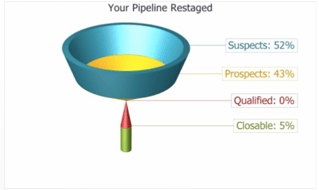
Assertive (not aggressive) salespeople win more business than others. They care so much about doing the right thing for their clients that they are willing to risk the relationship and the deal in order to make sure the prospect or client makes the right decisions. Does that describe your people? Are they assertive?
When we say assertive, what do we mean? What sales habits do assertive and successful people do day in and day out? In 2010, I wrote a blog entitled 5 Direct Sales Activities That Lead to Sales Success that has been one of my highest readership blogs. I went back and reviewed and here are the five steps:
- Activities that lead to getting names - networking, speaking engagements, sponsored seminars, meeting with centers of influence and/or asking for introductions
- Calling a suspect on the phone for an appointment
- Conversations and meetings to qualify a suspect
- Gathering additional information that leads to a presentation meeting
- Presentations/pitch meetings that lead to decisions
Steps 1 and 2 have changed dramatically in the last 6 years. Social selling and the evolution of the buyer’s process utilizing all of the multiple channels of information has completely changed the process of prospecting for business. Step 2 - getting a suspect on the phone - is virtually impossible with voicemails and phone trees.
Our Own Prospecting Case Study
Earlier this year, we decided to test the waters for our hiring business solution, www.hirebettersalespeople.com. We had some initial success right off the bat with our launch in January of 2016, but then activity seemed to cool down. We purchased a local lead list based on company size and title and I began calling. Here are the calling results:
- 66% of the dials took me directly into a recorded phone tree
- 25% of the calls took me to a receptionist who was very helpful and informative but transferred me to voicemail
- Of the remaining 9%, I had in depth conversations with 3 people, met with one and generated one sale from that contact
3 people fit our profile; I met with 1 and sold that one… but not to help them hire better salespeople, but rather to help them test, train and track some of the salespeople that were not “hitting their weight”. The second was not interested at the time and the 3rd introduced me to someone in the home office. That contact has put us in the middle of negotiations for a 5-figure initial engagement.
I tell you that story to make the following points about step #2:
- Calling prospects on the phone doesn’t work like it used to.
- It requires more attempts and effort than ever before - you have to have a different tactic and message to differentiate yourself.
- Once you make contact, you have to be extremely good at what you do and have a compelling reason for people to listen and stay on the phone. THAT is where being more assertive makes a difference.
Steps 3, 4, 5: How to be More Assertive at Qualifying, Presenting and Getting Decisions
In our primary markets of financial institutions, investment services and insurance brokerage, we ARE the resource for sales growth solutions. We coach our clients on the fact that the reason for either their sales growth or loss is due to their peoples’ 1) effort or 2) execution. But what does assertiveness have to do with Effort and Execution of steps 3,4 and 5? In a word, EVERYTHING.
Steps 3,4, and 5:
- Conversations and meetings to qualify a suspect
- Gathering additional information that leads to a presentation meeting
- Presentations/pitch meetings that lead to decisions
In each one of these steps, the skill of asking the right questions, the right way, at the right time is critical. In our selling system, we explain that - in order for a prospect to qualify - they must:
- Have compelling reasons to buy, make a change, do something different
- Have the capability and willingness to invest the right time, money and effort required for the purchase/change
- Be in a position of decision making and be able to make the decision to find a solution to the compelling (have to fix) issue, can make the money decision, can leave a current or add to a current relationship, and say yes or no.
There are lots of questions that need to be asked in order to find out if the prospect qualifies in these three areas. Some of these questions require a sales person to be assertive. Questions such as:
- How will you go about telling your current broker/banker/relationship that you are no longer going to do business with them?
- If you don’t have the money, how will you solve the problem?
- The budget you have won’t be enough to get you the outcome you want. What part of the solution do you want to eliminate?
- What will you tell your partner when they say they don’t want to make the change?
Additionally, sometimes statements are required that would be considered counter-intuitive to selling, gutsy and risky.
- Based on our experience and deep domain knowledge about your business, your best action to take would be this: ________. If that doesn’t seem to work for you, then there’s a possibility that we won’t be a good match.
- If I treated my clients the way you’ve been treated, then I would expect to be fired.
- When we finish our presentation, solve all of the problems you’ve asked us to address within your budget and answered all your questions, I’ll need for you to be in a position to make a decision on whether we’ll do business together or not.
- Maybe the most important thing for you to consider is “fit”. If there isn’t a fit between our two companies, then our products and pricing really don’t matter.
Imagine for a second that you had salespeople that were gutsy enough to have these types of conversations. What would happen? You might fear that you would lose more business. But… suppose that wasn’t the case. Suppose by being more assertive and gutsy, your salespeople eliminated tire kickers earlier. Suppose this lead to the elimination of “think it overs” and actually got people to decide. Imagine for a second that your salespeople stopped making presentations to people who could only say “no” and never had the authority or intention of saying “yes”. What would happen?
Your people would sell more, more quickly, at higher margins. They would stop wasting time, stop getting delays, stop being shopped by a prospect that was just trying to keep a current provider honest.
Here’s How Sales Managers Can Get Their Salespeople to be More Assertive
Sales managers must hold their salespeople accountable to the right level of sales activity. To do this, you must have a success formula and a well-defined sales process so that you can identify where the choke points are for individuals when they fail to close “sure thing” opportunities. You must also have a pipeline tool that actually helps you predict the possibility of an opportunity closing rather than a tool that just reports that there is activity in the pipeline. And, finally, you must have a full pipeline – an anemic pipeline makes cowards out of salespeople. These are the tools you will need to help your salespeople be more assertive and close more business, more quickly, at higher margins.

 Salespeople have to prospect – that’s the truth. Salespeople can find their prospects through a variety of different avenues, including; introductions, direct mail, internet offers, networking, internal referrals from business partners, cold calling, campaigns, association memberships, and business networking groups.
Salespeople have to prospect – that’s the truth. Salespeople can find their prospects through a variety of different avenues, including; introductions, direct mail, internet offers, networking, internal referrals from business partners, cold calling, campaigns, association memberships, and business networking groups. 






